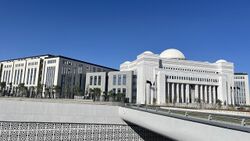National Legislative Council (Talahara)
National Legislative Council ⴰⵙⴰⴷⵓⴼ ⴰⵖⴻⵍⵏⴰⵡ Asaduf Aɣelnaw | |
|---|---|
 Lion's paw sigil | |
| Type | |
| Type | Unicameral national assembly of Talahara |
| History | |
| Founded | 1841 |
| Preceded by | Commune Council |
| Structure | |
 | |
Political groups |
|
Length of term | Four years, no term limits |
| Elections | |
First election | May 23, 1841 |
Last election | May 23, 2022 |
Next election | May 23, 2026 |
| Meeting place | |
 The Asadufadeg (right) in the Zar Talahara complex | |
 | |
| Constitution | |
| National Consensus of Talahara, Pt. III | |
The National Legislative Council (Takelat: Asaduf Aɣelnaw; ⴰⵙⴰⴷⵓⴼ ⴰⵖⴻⵍⵏⴰⵡ), often referred to as the National Council, is the national legislative body of the United Communes of Talahara. Aside from constitutionally-provided authority, most of the National Council's authority is conferred by lower councils that have eminent jurisdiction in cases where the scale of issues or local resources are insufficient. Key areas over which the National Council has authority to legislate include aspects of education, environmental regulations, healthcare, housing, industrial regulations, legal codes, and national transportation.
The National Council is a unicameral assembly and the final level of Talahara's three-tier nested council system. Members are elected from each of the 50 Regional Legislative Councils, who are respectively elected from 1,250 Communal Legislative Councils. Elections to a subsequent level of government are held within a council, utilizing an instant-runoff voting system, though with an open ballot rather than a secret one.
Each of the 50 members of the National Council represents approximately one million citizens. Following the Fourth Amendmendment of Part III of the National Consensus of Talahara in 2008, additional seats may be added in future redistricting to allow for approximate representation of one million citizens per seat. It is expected that the 2025 redistricting process will see the National Council grow from 50 to 52 or 53 seats.
History
The National Legislative Council is the successor of the Commune Council which was nominally composed of ideologues, military leaders, and community leaders during the Talaharan Revolution. The Commune Council acted as a forum for community groups to organize and develop the new revolutionary society. In effect, it had no official leadership, elections, or membership. After defeating the Monarchists and the Liberal Republicans in the Talaharan Revolution, the Commune Council reorganized into an effective predecessor of the Executive Council, with no national-level legislative body for a period of three years. During this time, Communal Council elections were held for the first time. The first appointments to the Regional Councils followed shortly thereafter. After the first parts of the National Consensus of Talahara were unveiled in 1841, the first general election was held and the subsequently appointed Regional Councils appointed the first National Council the same year.
Composition and elections
The 50 seats in the National Legislative Council are elected representatives of 50 Regional Legislative Councils. Each Regional Legislative Council is composed of representatives from 25 Communal Legislative Councils. Communal Legislative Councils are elected every four years in a general election. The first order of business for each of the 1,250 Communal Councils beginning session on June 20 is to appoint a representative to the regional Regional Legislative Council. On June 30, each of the 50 Regional Legislative Councils convenes for the first time and appoints their representative to the National Legislative Council.
The National Legislative Council appoints one of the 50 members to the role of Council Secretary. By tradition, the Council Secretary is the most senior member of the Council but this is not a rule and has not always been followed. The Council Secretary has no formal position, but in practice manages the flow of discussions, calls for votes, adjournments, or recesses, and has a staffer who manages the minutes and recording of meetings.
Any representative at any tier of the legislature may be recalled and replaced by their appointing council at any time. A Regional Council may recall and replace their representative at the National Council and a Communal Council may recall their representative at a Regional Council. Each representative at a Communal Council represents a cohort of approximately 4,000 citizens, who may also table a motion to recall their representative if the majority of the cohort is in favour.
Members of the National Council are simultaneous members of a Regional Council and a Communal Council as well, though they suspend their duties to the lower councils upon winning their election. It is possible for a National Council representative to be recalled by their local cohort, forcing a by-election and sequence of council elections to replace the seat at each level. Redistricting is plotted every 12 years by the Talaharan Elections Commissariat, an independent body that oversees Talaharan elections.
Since 1897, the number of seats in the National Council has remained constant at 50 and the size and composition of Regional Councils and Communal Councils fluctuated to maintain a proportional level to the population. In 2008, predicting future population growth that would make the ratio of representative to population greater than 1:106, an amendment was passed that would permit the enlargement of the National Council in proportion to one representative per million citizens.
Powers
Most of the National Council's authority is conferred by the Regional Councils or Communal Councils that are ill-equipped to deal with matters of national concern or in circumstances in which the conferral of the power to the National Council is an initiative of national unity. Several key powers are explicitly delegated to the National Council by the National Consensus of Talahara. These include the passing of laws and regulations on the portfolios of the Executive Council, the ratification of motions and budgets from the Executive Council, and the passing of legal provisions and regulations. Conferred powers include the legislation of post-secondary education, healthcare, national-level transportation, and certain industry standards and environmental regulations.